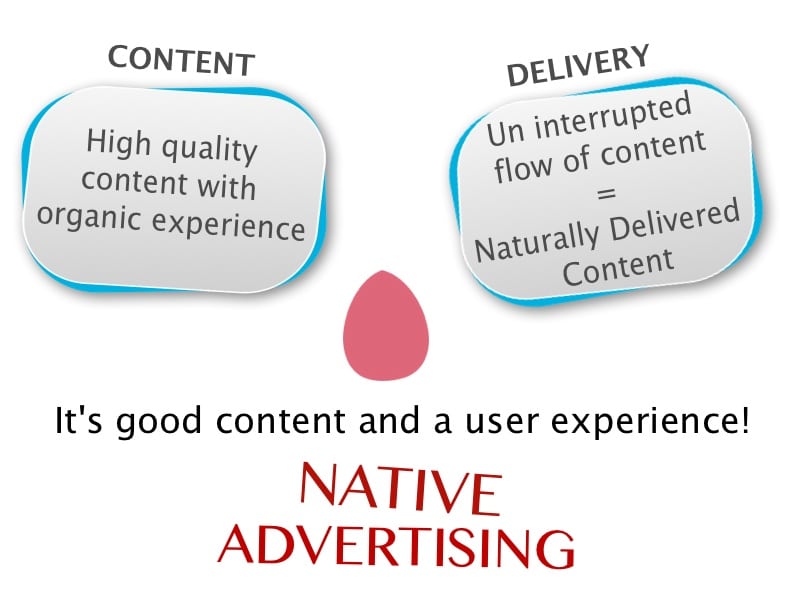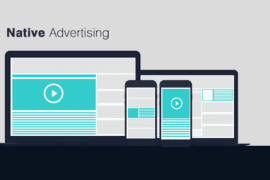Being a marketer myself, I can tell you that we are always on the lookout for new jargons to categorize our campaigns, tools and ideas. But that doesn’t mean we don’t have an influence over the industry’s value chain. Like every industry, marketers and advertisers have to evolve to keep up with the every changing consumer. Thanks to media and technology for that.
One of the jargons, that is on the rise these days is something called “Native Advertising.” However confusing the term may sound, it is quite a straight forward concept. A few years ago, when traditional media advertising was on the rise, marketers complained about the high clutter levels (they still do). And because of that, some new marketing formats came into being: branded content and content integration.
Both branded content and content integration were about endorsing the brand’s presence as part of the content. For example, if guys were sitting in a cafeteria on a popular show, marketers would integrate a cold beverage as a social drink in that scenario. This did wonders for brands because the consumers were able to relate to the brand in a scenario that appeals to them, instead of a 30 second commercial during the break that has a very high chance of getting skipped. Content led brands to integrate their offerings within consumer lifestyles. This is a form of native advertising on TV.
You can think about native advertising as a similar concept, if not the same, in an online context. Display or banner advertising has been done to a point where the consumers deliberately prefer not to click on them. Yes. They are more aware of the tactics. The brand teams are not getting the ROI that they once used to get. Now that’s a problem isn’t it?
But why worry when there is native marketing on the rise! To clarify the concept of native advertising further, you can think of it as a polygamy between display advertising + social media + content. It is a smart way of advertising instead of using the machine gun approach of blasting banner advertising through an adserver across tons of websites. Now imagine a published article on one of your favourite website, but you don’t realize that the specific content is branded or sponsored. Makes sense?
The post, 15 Reasons Why Cats Are The Most Fearless Creatures, is native advertising with BuzzFeed. Similarly, Facebook sponsored stories may also be considered native advertising by many because this advertising format exploits the power of the Facebook news feed. Publishers charge the advertisers based on the reach they deliver for that content. Cool? It is like a win / win for everyone: publisher, advertiser and the consumer.
Folks at Software Advice have written a detailed post about native advertising from a B2B perspective. Following are 3 core things that I felt as being most important to launching a more effective native advertising campaign for B2B as well as B2C brands.
1. Relevant Native Advertising Platforms
Marketing is all about relevancy, and the same goes for native advertising. It is the first and the most important element to any marketing campaign. It cannot be stressed enough. For example, I cannot see relevance in a chemical manufacturer on Facebook trying to run an advertising campaign. I know the example is exaggerated, but if you know your brand or business well, you can figure out the right and relevant platforms for it with some strategic effort. I think Linkedin and Quora are great and untapped opportunities for many businesses. I experienced the power of Linkedin myself when I was running my ideation agency.
2. Consumer-Centric Communication
Some might disagree to the example I gave about the chemical manufacturer, but relevance is a key element. A different way to look at the same example is to say that a chemical manufacturer wants to run a public interest awareness campaign about the hazards of copper. Now that makes more sense. Relevant information for relevant consumers.
3. Don’t be cheesy when it comes to Branding
This is one’s my favourite. For God’s sake, don’t over brand the content or event or any other form of native advertising. It kills the purpose in the first place. Consumers are smart, and you look stupid. Trust me. I have worked for many marketers during my agency experience and have had the honour (sarcasm… duh) of working with some who believe that it is a great idea to even brand the faces, butts and whatever they can get, of their consumers with a brand logo. You know those people who overly stuff themselves at the opportunity of getting free food? Over-branding looks exactly the same. Don’t over-kill; just do what is enough. Sometimes even one logo at the corner serves the purpose well.







